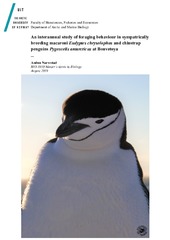Circumpolar Arctic vegetation: a hierarchic review and roadmap toward an internationally consistent approach to survey, archive and classify tundra plot data
Permanent link
https://hdl.handle.net/10037/10359Date
2016-05-10Type
Journal articleTidsskriftartikkel
Peer reviewed
Author
Walker, D. A.; Daniels, F.J.A.; Alsos, Inger Greve; Bhatt, U S; Breen, A L; Buchhorn, M; Bultmann, H; Druckenmiller, L A; Edwards, M E; Ehrich, Dorothee; Epstein, Howard E.; Gould, W.A.; Ims, Rolf Anker; Meltofte, H; Raynolds, M. K.; Sibik, J; Talbot, SS; Webber, P. J.Abstract
Satellite-derived remote-sensing products are providing a modern circumpolar perspective of Arctic
vegetation and its changes, but this new view is dependent on a long heritage of ground-based
observations in the Arctic. Several products of the Conservation of Arctic Flora and Fauna are key to
our current understanding.Wereview aspects of the PanArctic Flora, the Circumpolar Arctic
Vegetation Map, the Arctic Biodiversity Assessment, and the Arctic Vegetation Archive (AVA) as they
relate to efforts to describe and map the vegetation, plant biomass, and biodiversity of the Arctic at
circumpolar, regional, landscape and plot scales. Cornerstones for all these tools are ground-based
plant-species and plant-community surveys. TheAVA is in progress and will store plot-based
vegetation observations in a public-accessible database for vegetation classification, modeling,
diversity studies, and other applications.Wepresent the current status of the Alaska Arctic Vegetation
Archive (AVA-AK), as a regional example for the panarctic archive, and with a roadmap for a
coordinated international approach to survey, archive and classify Arctic vegetation.Wenote the need
for more consistent standards of plot-based observations, and make several recommendations to
improve the linkage between plot-based observations biodiversity studies and satellite-based
observations of Arctic vegetation.
Description
Publisher
IOP PublishingCitation
Walker DA, Daniels F, Alsos IG, Bhatt, Breen, Buchhorn, Bultmann, Druckenmiller, Edwards ME, Ehrich D, Epstein HE, Gould W, Ims RA, Meltofte H, Raynolds MK, Sibik, Talbot S, Webber PJ. Circumpolar Arctic vegetation: a hierarchic review and roadmap toward an internationally consistent approach to survey, archive and classify tundra plot data. Environmental Research Letters. 2016;11:055005Metadata
Show full item recordCollections
Related items
Showing items related by title, author, creator and subject.
-
An interannual study of foraging behaviour in sympatrically breeding macaroni Eudyptes chrysolophus and chinstrap penguins Pygoscelis antarcticus at Bouvetøya
Narvestad, Audun (Master thesis; Mastergradsoppgave, 2019-08-15)Species are likely to segregate their ecological niches to minimize competition for resources, but for centrally foraging predators that breed on sub-Antarctic islands in the Southern Ocean the possibility of niche segregation may be minimal. This study is the first to examine the spatial and trophic aspects of the foraging niche of sympatrically breeding macaroni and chinstrap penguins at the ... -
Pseudocalanus (Copepoda: Calanoida) of the North Atlantic Ocean : species composition, environmental preferences and phylogeography
Aarbakke, Ole Nicolai S (Doctoral thesis; Doktorgradsavhandling, 2013-06-25)The seven species of the genus Pseudocalanus (Copepoda: Calanoida) are difficult to identify because of very small interspecific, and comparatively large intraspecific, divergence of morphologic and morphometric traits. Thus, despite the fact that Pseudocalanus spp. are among the most abundant metazoans in the world, our knowledge of them at the species level is limited. The main objective of this ... -
A new genus of horse from Pleistocene North America
Heintzman, Peter D.; Zazula, Grant D.; MacPhee, Ross D. E.; Scott, Eric; Cahill, James A.; McHorse, Brianna K.; Kapp, Joshua D.; Stiller, Mathias; Wooller, Matthew J.; Orlando, Ludovic; Southon, John R.; Froese, Duane G.; Shapiro, Beth (Journal article; Tidsskriftartikkel; Peer reviewed, 2017-11-28)The extinct ‘New World stilt-legged’, or NWSL, equids constitute a perplexing group of Pleistocene horses endemic to North America. Their slender distal limb bones resemble those of Asiatic asses, such as the Persian onager. Previous palaeogenetic studies, however, have suggested a closer relationship to caballine horses than to Asiatic asses. Here, we report complete mitochondrial and partial nuclear ...


 English
English norsk
norsk


